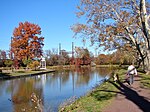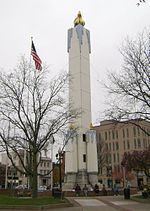Easton station (Pennsylvania)
Demolished railway stations in the United StatesFormer Lehigh Valley Railroad stationsFormer railway stations in PennsylvaniaPages with no open date in Infobox stationPennsylvania railway station stubs

Easton is a defunct train station in Easton, Pennsylvania. It was originally built by the Lehigh Valley Railroad. As of 2017, the structure still exists and was blighted for at least 20 years, since its closing in the 1970s. The city of Easton obtained permission from Norfolk Southern Railway to clean up the property. The location only recently became a focal point for the city with the opening of Interstate 78 in the 1990s.The Central Railroad of New Jersey (CNJ) had an Easton station of its own on the other side of the Lehigh River.
Excerpt from the Wikipedia article Easton station (Pennsylvania) (License: CC BY-SA 3.0, Authors, Images).Easton station (Pennsylvania)
D&L Trail, Easton
Geographical coordinates (GPS) Address Nearby Places Show on map
Geographical coordinates (GPS)
| Latitude | Longitude |
|---|---|
| N 40.6861 ° | E -75.2084 ° |
Address
D&L Trail
18042 Easton
Pennsylvania, United States
Open on Google Maps











